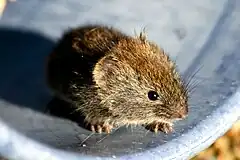| Craseomys | |||
| G.S. Miller, 1900[1] | |||
 Przedstawiciel rodzaju – nornica szaroruda (C. rufocanus) | |||
| Systematyka | |||
| Domena | |||
|---|---|---|---|
| Królestwo | |||
| Typ | |||
| Podtyp | |||
| Gromada | |||
| Podgromada | |||
| Rząd | |||
| Podrząd | |||
| Infrarząd | |||
| Nadrodzina | |||
| Rodzina | |||
| Podrodzina | |||
| Plemię | |||
| Rodzaj |
Craseomys | ||
| Typ nomenklatoryczny | |||
|
Hypudaeus rufocanus Sundevall, 1846 | |||
| Synonimy | |||
|
| |||
| Podrodzaje i gatunki | |||
| |||
Craseomys – rodzaj ssaków z podrodziny karczowników (Arvicolinae) w obrębie rodziny chomikowatych (Cricetidae).
Zasięg występowania
Rodzaj obejmuje gatunki występujące w północnej Europie (Norwegia, Szwecja, Finlandia, europejska część Rosji) i Azji (azjatycka część Rosji, Mongolia, Chińska Republika Ludowa, Korea Północna, Korea Południowa i Japonia)[4][5].
Morfologia
Długość ciała (bez ogona) 70–149 mm, długość ogona 25–68 mm; masa ciała 20–76,7 g[5][6].
Systematyka
Rodzaj zdefiniował w 1900 roku amerykański botanik i zoolog Gerrit Smith Miller na łamach Proceedings of the Biological Society of Washington[1]. Na gatunek typowy Miller wyznaczył (oryginalne oznaczenie) nornicę szarorudą (C. rufocanus).
Etymologia
- Craseomys: gr. κρασις krasis, κρασεως kraseōs ‘mieszanina, połączenie’[7]; μυς mus, μυος muos ‘mysz’[8].
- Phaulomys: gr. φαυλος phaulos ‘słaby, kiepski’[9]; μυς mus, μυος muos ‘mysz’[8][2]. Gatunek typowy: Evotomys (Phaulomys) smithii O. Thomas, 1905.
- Neoaschizomys: gr. νεος neos ‘nowy’[10]; rodzaj Aschizomys G.S. Miller, 1899 (górzak). Gatunek typowy: Neoaschizomys sikotanensis Tokuda, 1935 (= Hypudaeus rufocanus Sundevall, 1846).
Podział systematyczny
Do rodzaju należą następujące występujące współcześnie gatunki zgrupowane w dwóch podrodzajach[11][6][4][12]:
- Craseomys G.S. Miller, 1900
- Craseomys rufocanus (Sundevall, 1846) – nornica szaroruda
- Craseomys rex (Imaizumi, 1971) – nornica królewska
- Phaulomys O. Thomas, 1905
- Craseomys regulus O. Thomas, 1907 – nornica koreańska
- Craseomys andersoni (O. Thomas, 1905) – nornica wyspowa
- Craseomys smithii (O. Thomas, 1905) – nornica japońska
Opisano również gatunek wymarły z plejstocenu dzisiejszej Japonii[13]:
- Clethrionomys japonicus Kawamura, 1988
Przypisy
- 1 2 G.S. Miller. Preliminary revision of the European redbacked mice. „Proceedings of the Biological Society of Washington”. 2, s. 87, 1900. (ang.).
- 1 2 O. Thomas. On some new Japanese Mammals presented to the British Museum by Mr. R. Gordon Smith. „The Annals and Magazine of Natural History”. Seventh series. 15, s. 493, 1905. (ang.).
- ↑ M. Tokuda. Neoaschizomys, a new genus of Microtinae from Sikotan, a South Kuril’ Island. „Memoirs of the College of Science, Kyoto Imperial University”. Series B. 10 (3), s. 242, 1935. (ang.).
- 1 2 C.J. Burgin, D.E. Wilson, R.A. Mittermeier, A.B. Rylands, T.E. Lacher & W. Sechrest: Illustrated Checklist of the Mammals of the World. Cz. 1: Monotremata to Rodentia. Barcelona: Lynx Edicions, 2020, s. 346. ISBN 978-84-16728-34-3. (ang.).
- 1 2 U. Pardiñas, P. Myers, L. León-Paniagua, N.O. Garza, J. Cook, B. Kryštufek, R. Haslauer, R. Bradley, G. Shenbrot & J. Patton. Opisy gatunków Cricetidae: U. Pardiñas, D. Ruelas, J. Brito, L. Bradley, R. Bradley, N.O. Garza, B. Kryštufek, J. Cook, E.C. Soto, J. Salazar-Bravo, G. Shenbrot, E. Chiquito, A. Percequillo, J. Prado, R. Haslauer, J. Patton & L. León-Paniagua: Family Cricetidae (True Hamsters, Voles, Lemmings and New World Rats and Mice). W: D.E. Wilson, R.A. Mittermeier & T.E. Lacher (redaktorzy): Handbook of the Mammals of the World. Cz. 7: Rodents II. Barcelona: Lynx Edicions, 2017, s. 299–301. ISBN 978-84-16728-04-6. (ang.).
- 1 2 Class Mammalia. W: Lynx Nature Books: All the Mammals of the World. Barcelona: Lynx Edicions, 2023, s. 223. ISBN 978-84-16728-66-4. (ang.).
- ↑ Jaeger 1959 ↓, s. 69.
- 1 2 Jaeger 1959 ↓, s. 160.
- ↑ Jaeger 1959 ↓, s. 192.
- ↑ Jaeger 1959 ↓, s. 165.
- ↑ N. Upham, C. Burgin, J. Widness, M. Becker, C. Parker, S. Liphardt, I. Rochon & D. Huckaby: Treeview of Mammalian Taxonomy Hierarchy. [w:] ASM Mammal Diversity Database (Version 1.11) [on-line]. American Society of Mammalogists. [dostęp 2023-10-03]. (ang.).
- ↑ Nazwy polskie za: W. Cichocki, A. Ważna, J. Cichocki, E. Rajska-Jurgiel, A. Jasiński & W. Bogdanowicz: Polskie nazewnictwo ssaków świata. Warszawa: Muzeum i Instytut Zoologii PAN, 2015, s. 238–239. ISBN 978-83-88147-15-9. (pol. • ang.).
- ↑ Y. Kawamura. Quaternary rodent faunas in the Japanese islands (Part 1). „Memoirs of the Faculty of Science, Kyoto University, Series of Geology & Mineralogy”. 53 (1–2), s. 214, 1988. (ang.).
Bibliografia
- E.C. Jaeger: Source-book of biological names and terms. Wyd. 3 (Revised second printing). Springfield: Charles C. Thomas, 1959, s. 1–316. (ang.).